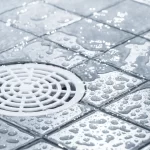Here we’ll talk all about why you might need to dig up (aka excavate) your main drain.
No one likes to dig up their property and destroy their landscaping (us included!), but sometimes it has to be done to solve the underlying problems with your drain or sewer.
Often drain problems are minor issues, like a clogged toilet which can usually be solved with a plunger. However, if you’ve noticed serious problems with clogging or slow drainage, it might be a serious drain problem.
even with no-dig methods, sometimes we still need to excavate
Now, just because you have a major drain problem doesn’t automatically mean we need to excavate. In most situations, a drain contractor will be able to handle the issue with one of a few different no-dig drain repair methods. These new no-dig methods are really amazing and can save a lot of time and money by allowing pipes to be replaced or repaired without digging.
But that’s only when we can use them. Unfortunately, even with no-dig methods, sometimes we still have to excavate.

We’re sorry, we don’t want to dig up your landscaping either!
Digging: Not Easy or Fun, But Very-Effective
Let’s face it, no one wants to dig up their property.
But sometimes it is the only way to solve the problem. You can rest assured though once we get to the problem it will be fixed once and for all. In fact, when we provide service we offer a 25-year warranty on all main drain work, that’s how confident we are in this sort of work.
The truth is that most plumbers and homeowners prefer no-dig methods for repairing or replacing drain lines. In this post, we are going to look at drain excavation specifically and the options that you have when drain repairs are necessary.
When Does a Drain Need to be Repaired or Replaced?
We wish this had an easy answer, but the answer to this question depends on a number of factors.
The most important factors are:
- What the pipe is made out of
- The condition of the soil near the pipe
- In the case of a blockage, how serious it is
- Ecological or environmental circumstances
- Other factors …
Here’s a bit more on these issues:
1. The Pipe Material Does Not Support No-Dig Methods
A sewer line could be made from a wide range of different materials. You have metal pipes, clay, plastic, concrete, and a whole host of other materials. As the line ages, corrosion can wear away at the materials, or the joints could start to go.
The pipe material plays a major role in how we solve the problem.
2. Inappropriate Soil Conditions
The soil conditions around the line can cause problems. Depending on the conditions, the line could crack or collapse, freezing soil can damage lines and you may find issues where the soil shifts and causes part of the sewer line to go out of pitch.
If the soil is not in the right condition, we won’t be able to use our fancy no-dig repair techniques.
3. Blockages That Are Impossible To Clear
Sewer lines can also get blocked by obstructions. Now usually a plumber can remove an obstruction from the line, but there are some blockages that will not move at all without accessing the pipe. Usually, this is the case in lines that have corrosion built up, we have to remove the section of pipe and replace it entirely.
Even with modern drain cleaning methods, sometimes a pipe is completely blocked and we need to remove it.
4. Packed With Tree Roots
If you have a large tree on your property, the roots could invade the line in a bad way and cause major problems. When roots grow into the line, they not only damage the drain, but can also cause a blockage that will be difficult, or impossible to remove.
There are special machines we use which chop up roots and debris in drain or sewer lines. But sometimes they’re just no match for a determined tree.
A number of issues exist which could result in the need for excavation. These might require the entire line to be replaced, or just a section needing repairs. But often, it isn’t just one problem. Instead, you have a variety of factors that come together to damage the drain line.
If you suspect that your drain might need repairs or replacement, you need to call a plumbing contractor in Toronto. The plumber can inspect the line using a drain inspection camera, and they will be able to recommend and perform the necessary repairs.
How do I know if my drain needs repairs?
There are a number of ways you can tell if you have a drain problem.
But remember if you have a compromised sewer line, it is important to get it fixed right away. A damaged drain can contribute to other problems in the home, and it can also lead to living conditions that are unsanitary.
Keep an eye out for these telling signs:
1. Your Drains Are Clogged or Blocked
One of the most obvious signs is a problem with blockages to the line. This is especially true if the blockages occur to more than one drain. If you have noticed that you have blockages to multiple drains, it is a sign that your sewer line has a problem. If you get the lines cleared only to find that they repeatedly have problems, this is another sign that there is an issue.
2. Your Water Drains Slower Than It Used To
In some cases, the drains are not completely blocked, but you may notice that your sinks or toilets seem to drain slowly, or that you have to flush more than once for the toilet to empty. This is another sign of a problem. In this case, the line might not be completely blocked off, but there is some type of obstruction that is limiting the flow on the drain line.
3. You Smell Sewer Gas Near Sinks or Toilets
The smell of sewer gas around sinks and toilets can indicate that there is a problem with the line. You may also notice the smell of sewer gas around the property. This could be a sign that the line is broken or cracked. If you start to smell sewer gas around the home, it is time to call a plumber.
4. See Indentations and/or Sinkholes on Your Property
When a sewer line leaks, it can affect the soil in the surrounding area. In some cases, this might cause the soil to dissipate and this could lead to an indentation in the lawn near where the sewer line is. In some extreme cases, it may even result in a sinkhole on the property.
5. Unexplained Patches of Healthy Grass on Your Property
The waste that leaks from your sewer line can act as a fertilizer and make for an area of the lawn that is particularly lush. You may think that area of the lawn looks great, but it might be a sign that your sewer line is leaking.
What about trenchless drain repair?
Excavation used to be the only option if you needed to repair or replace your drain lateral. Since the development of trenchless drain repair methods, they have become the favoured option for most plumbers and drain repair specialists.
With excavation, you have some problems that don’t come with trenchless drain repair.
- The excavation process takes more time and effort. This increases the cost of the repair.
- Excavation is usually very disruptive to property. The excavation process can damage landscaping and you may even need to dig under things like patios and walkways.
There might be the need for some minor excavation, but it is not nearly as extensive as having to dig up the entire line. This cuts the time and the cost down significantly and it also saves on all of the damage that could be done to landscaping and hardscaping that might be on the property.
When you talk about trenchless drain repair, you have two basic options: cured-in-place pipe lining (CIPP) and pipe bursting. Both of these methods can be used to provide effective, durable repairs for damaged drain lines, but they both have their own ideal applications.
With CIPP, a liner is applied to the damaged pipe. This liner is held in place using air pressure and an epoxy resin is used to fix the liner to the pipe and seal off the damage. This can be good for sealing cracks and punctures to pipes that are underground, and it provides a very reliable solution that is also cost-effective.
Pipe bursting is a method for replacing underground pipes without having to dig the entire line up. With pipe bursting, the new pipe is run down the existing line. The new pipe is fitted with a bursting head that is used to crack and displace the old line. As it is pulled through the line, the old pipe breaks and the new pipe takes its place.
These two methods alone can be used to address a wide range of issues where an underground pipe needs to be repaired or replaced. That being said, there are still some situations where excavation is the only option.
When is excavation needed?
At this point, you might be wondering why people don’t just use trenchless drain repairs for every repair or replacement project. It costs less, it is less disruptive, it is less invasive and it can be done in less time. In any situation where it is a viable option, a plumber is likely to go with a trenchless option, but there are some factors that can take these options off the table.
One point is that CIPP is only good for repairs. If the pipe needs to be replaced, CIPP is an option that is not going to get the job done. Some repairs may also be beyond the capabilities of a liner. If a joint in the line is broken, you might need to excavate. If the repair is long and far from the access to the line, a liner might not be able to cover the problem.
Pipe bursting also comes with its own issues. When the pipe and bursting head are being pulled down the line, it causes vibration in the soil. Depending on the soil conditions, this could be a problem. If the line runs too close to other utilities, pipe bursting might cause a problem for other lines that are run nearby. You also have to consider the material. Pipe bursting will not work with certain materials. Depending on where you live, you may also have to consider issues with permits. Some municipalities require special permits for pipe bursting, and there are even some that do not allow it at all.
If one of the trenchless repair methods is an option, there are definite advantages to using them. Your drain will get fixed in less time, you’ll spend less on the repair and you won’t have to worry about your yard getting dug up. However, you might have to accept excavation as the only option that is available. When it comes time to replace a drain line, your plumber should lay out all of your options and explain the positives and negatives of each option.=
Which option is better?
It’s not really a question of which of these repair options is best; the best repair is determined by the situation. In some cases, cured-in-place pipe lining will be the best repair for the situation, in others, you may have to go with pipe bursting or excavation. An experienced plumber will be able to inspect the drain line, evaluate all of the factors, and come to a recommendation for the best repair for the situation at hand.
With CIPP, you are looking at repairs for cracks and punctures to the line. In most of these situations, CIPP is the best repair. It provides a reliable repair that can last many years, it is relatively quick and it will not require a lot of digging. Most of the liners even come with an extensive warranty, so if there is a problem, you are covered.
Pipe bursting is the ideal solution for many situations where a pipe needs to be replaced or upsized. The new pipe can easily follow the line of the old pipe, and it makes for a reliable repair that will last many years. You can even replace runs that are very long with pipe bursting, but as I mentioned before, there are some situations where it is not an option.
Plumbers will generally only recommend excavation as a last resort. It means that the repair cannot be fixed by lining and that either the soil conditions, the material of the pipe or the presence of other utilities have ruled out the possibility of pipe bursting. If the pipe is improperly pitched, that might be another reason to go with a full excavation.
All of these options can provide good, reliable repairs. None of them is any better than the others. CIPP and pipe bursting might have some advantages that make them preferable, but it all comes down to the situation.
Sewer line problems can take on many different forms, and for that reason, there are different types of repairs that can be applied. If you are fortunate, you will be able to take advantage of one of the trenchless drain repair methods, but in some situations, they might be an option. If that is the case, a full excavation can still provide you with the repairs you need.






